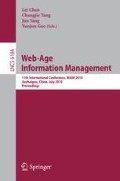Abstract
Book-loan is the most important library service. Studying users’ book-loan behavior patterns can help libraries to provide more proactive services. Based on users’ book-loan history in a university library, we could build a book-borrowing network between users and books. Furthermore, users who borrow the same books are linked together. The users and links then form a co-borrowing network which can be regarded as a knowledge sharing network. Both the book-borrowing network and the co-borrowing network can be used to study users’ book-loan behavior patterns. This paper presents a study in analyzing users’ book-loan behaviors and mining knowledge dependency between schools and degrees in Peking University. The mining work is based on the book-borrowing network and its corresponding co-borrowing network. To the best of our knowledge, it is the first work to mine knowledge dependency in digital library domain.
Access this chapter
Tax calculation will be finalised at checkout
Purchases are for personal use only
Preview
Unable to display preview. Download preview PDF.
References
Chinese library classification, http://en.wikipedia.org/wiki/Chinese_Library_Classification
Adamic, L.A., Buyukkokten, O., Adar, E.: A social network caught in the web. First Monday 8(6) (2003)
Adamic, L.A., Zhang, J., Bakshy, E., Ackerman, M.S.: Knowledge sharing and yahoo answers: Everyone knows something. In: Proceedings of ACM WWW 2008, pp. 665–674 (2008)
Barabasi, A.-L., Albert, R.: Emergence of scaling in random networks. Science 286(5439), 509–512 (1999)
Bollen, J., Luce, R., Vemulapalli, S.S., Xu, W.: Usage analysis for the identification of research trends in digital libraries. D-Lib. Magazine 9(5) (2003)
Chin, A., Chignell, M.H.: Identifying communities in blogs: roles for social network analysis and survey instruments. IJWBC 3(3), 345–363 (2007)
Guenther, K.: Applying data mining principles to library data collection. Computers in Libraries 20(4), 60–63 (2000)
Li, X., Guo, L., Zhao, Y.E.: Tag-based social interest discovery. In: Proceedings of ACM WWW 2008, pp. 675–684 (2008)
Loether, H.J., McTavish, D.G.: Descriptive and Inferential Statistics: An Introduction, 3rd edn. (1988)
Mislove, A., Marcon, M., Gummadi, K., Druschel, P., Bhattacharjee, B.: Measurement and analysis of online social networks. In: Proceedings of ACM IMC 2007, pp. 29–42. ACM, New York (2007)
Newman, M.E.J.: The structure of scientific collaboration networks. Proceedings of the National Academy of Sciences (PNAS), 409–415 (2001)
Nicholson, S.: The basis for bibliomining: Frameworks for bringing together usage-based data mining and bibliometrics through data warehousing in digital library services. Journal of the American Society for Information Science and Technology 42(3), 785–804 (2006)
Singla, P., Richardson, M.: Yes, there is a correlation: - from social networks to personal behavior on the web. In: Proceedings of ACM WWW 2008, pp. 655–664 (2008)
Srivastava, J., Cooley, R., Deshpande, M., Tan, P.N.: Web usage mining: discovery and applications of usage patterns from web data. SIGKDD Explor. Newsl. 1(2), 12–23 (2000)
Wasserman, S., Faust, K.: Social Network Analysis Methods and Applications. Cambridge University Press, Cambridge (1994)
Yan, F., Jiang, J., Lu, Y., Luo, Q., Zhang, M.: Community discovery based on social actors’ interests and social relationships. In: SKG (2008)
Yan, F., Zhang, M., Sun, T., Lu, Y., Zhang, N., Xiao, L.: Analyzing user’s book-loan behaviors in peking university library from social network perspective. In: JCDL 2009, pp. 461–462. ACM, New York (2009)
Author information
Authors and Affiliations
Editor information
Editors and Affiliations
Rights and permissions
Copyright information
© 2010 Springer-Verlag Berlin Heidelberg
About this paper
Cite this paper
Yan, F., Zhang, M., Tang, J., Sun, T., Deng, Z., Xiao, L. (2010). Users’ Book-Loan Behaviors Analysis and Knowledge Dependency Mining. In: Chen, L., Tang, C., Yang, J., Gao, Y. (eds) Web-Age Information Management. WAIM 2010. Lecture Notes in Computer Science, vol 6184. Springer, Berlin, Heidelberg. https://doi.org/10.1007/978-3-642-14246-8_22
Download citation
DOI: https://doi.org/10.1007/978-3-642-14246-8_22
Publisher Name: Springer, Berlin, Heidelberg
Print ISBN: 978-3-642-14245-1
Online ISBN: 978-3-642-14246-8
eBook Packages: Computer ScienceComputer Science (R0)

